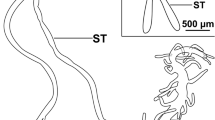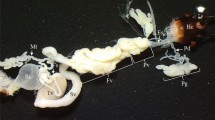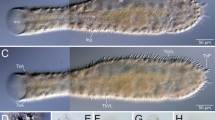Abstract
The prosomal salivary glands of the unfed larvae Leptotrombidium orientale (Schluger) were investigated using transmission electron microscopy. In total, four pairs of the prosomal glands were identified—three pairs, the lateral, the medial and the anterior, belong to the podocephalic system, and one pair, the posterior, is separate having an own excretory duct. All glands are simple alveolar/acinous with prismatic cells arranged around a relatively small intra-alveolar lumen with the duct base. The cells of all glands besides the lateral ones contain practically mature electron-dense secretory granules ready to be discharged from the cells. The secretory granules in the lateral glands undergo formation and maturation due to the Golgi body activity. The cells of all gland types contain a large basally located nucleus and variously expressed rough endoplasmic reticulum. Specialized duct-forming cells filled with numerous freely scattered microtubules are situated in the middle zone of each gland’s acinus and form the intra-alveolar lumen and the duct base. Both the acinar (secretory) and the duct-forming cells contact each other via gap junctions and septate desmosomes. Axons of nerve cells come close to the basal extensions of the duct-forming cells where they form the bulb-shaped synaptic terminations. The process of secretion is under the control of the nerve system that provides contraction of the duct-forming cells and discharge of secretion from the secretory cells into the intra-alveolar lumen and further to the exterior. Unfed larvae of L. orientale, the potential vector of tsutsugamushi disease agents, contain the most simply organized salivary secretory granules among known trombiculid larvae, and this secretion, besides the lateral glands, does not undergo significant additional maturation. Thus, the larvae are apparently ready to feed on the appropriate host just nearly after hatching.









Similar content being viewed by others
References
Alberti G (1973) Ernährungsbiologie und Spinnvermögen der Schnabelmilben (Bdellidae, Trombidiformes). Zeitschr Morphol Ökol Tiere 76:285–338
Alberti G, Coons LB (1999) Acari-Mites. In: Harrison FW (ed) Microscopic anatomy of invertebrates, vol 8C. Wiley, New-York, pp 515–1265
Alberti G, Crooker AR (1985) Internal anatomy. In: Helle W, Sabelis W (eds) Spider mites: their biology, natural enemies and control, vol 1A. Elsevier, Amsterdam etc, pp 29–62
Alberti G, Kitajima EW (2014) Anatomy and fine structure of Brevipalpus mites (Tenuipalpidae)—economically important plant-virus vectors. Zoologica 160:1–192
Alberti G, Storch V (1973) Zur Feinstruktur der “Munddrüsen” von Schnabelmilben (Bdellidae, Trombidiformes). Zetschr Wiss Zool 186:149–160
Alberti G, Storch V (1974) Über Bau und Funktion der Prosoma-Drüsen von Spinnmilben (Tetranychidae, Trombidiformes). Zeitschr Morphol Tiere 79:133–153
Bader C (1938) Beiträge zur Kenntnis der Verdauungsvorgänge bei Hydracarinen. Rev Suisse Zool 45:721–806
Beresanzev AYu (1980) Anatomy of the adult phases of mites Campylothrombidium boreale (Berl.) and Echinothrombidium spinosum (Can.) (Acarina, Trombidiidae). Vestn Leningradsk Univ 3: 14–21 (In Russian)
Blauvelt WE (1945) The internal morphology of the common red spider mite (Tetranychus telarius Linn.). Mem Cornell Univ Agric Exp Sta 270:1–46
Brown JRC (1952) The feeding organs of the adult of the common “chigger”. J Morphol 91:15–52
Cohen AC (1995) Extra-oral digestion in predaceous terrestrial Arthropoda. Annu Rev Entomol 40:85–103
Cohen AC (1998) Solid-to-liquid feeding: the inside(s) story of extra-oral digestion in predaceous Arthropoda. Am Entomol 44:103–116
Coons LB, Alberti G (1999) Acari: ticks. In: Harrison FW (ed) Microscopic anatomy of invertebrates, vol 8B. Wiley, New-York, pp 267–514
Croneberg AI (1878) On the structure of Eylaïs extendens (O. F. Müller) with notes on some related forms. Izv Imp Obzch Lub Est Antr Etn 29:1–37 (In Russian)
Henking H (1882) Beiträge zur Anatomie, Entwicklungsgeschichte und Biologie von Trombidium fuliginosum Herm. Zeitschr Wiss Zool 37:553–663
Jones BM (1950) The penetration of the host tissue by the harvest mite, Trombicula autumnalis Shaw. Parasitology 40:247–260
Michael AD (1895) A study of the internal anatomy of Thyas petrophilus, an unrecorded Hydrachnid found in Cornwall. Zool Soc Lond Proc 1895:174–209
Michael AD (1896) The internal anatomy of Bdella. Trans Linn Soc Lond Zool 6:477–528
Mills LR (1973) Morphology of glands and ducts in the two-spotted spider mite, Tetranychus urticae Koch, 1836. Acarologia 15:218–236
Mitchell RD (1955) Anatomy, life history and evolution of the mites parasitizing fresh water mussels. Misc Publ Mus Zool Univ Michigan 89:1–41
Mitchell RD (1964) The anatomy of an adult chigger mite Blankaartia acuscutellaris (Walch). J Morphol 114:373–391
Mitchell RD (1970) The evolution of a blind gut in trombiculid mites. J Nat Hist 4:221–229
Moss WW (1962) Studies on the morphology of the trombidiid mite Allothrombium lerouxi Moss (Acari). Acarologia 4:313–345
Mothes U, Seitz K-A (1981) Fine structure and function of the prosomal glands of the two-spotted spider mite, Tetranychus urticae (Acari, Tetranychidae). Cell Tissue Res 221:339–349
Pinkstaff CA (1980) The cytology of salivary glands. Int Rev Cytol 63:141–261
Schmidt U (1935) Beiträge zur Anatomie und Histologie der Hydrachniden, besonders von Diplodontus despiciens O. F. Müller. Zeitschr Morphol Ökol Tiere 30:99–176
Shatrov AB (1982) Structure and functional peculiarities of salivary glands of larvae of trombiculid mites (Trombiculidae). Parasitologiya 16:315–326 (In Russian, with English summary)
Shatrov AB (1989a) Salivary glands organization in fed deutonymphs and adult mites Hirsutiella zachvatkini Schlug. (Acariformes, Trombiculidae). Ent Obozr 68:882–893 (In Russian, with English summary)
Shatrov AB (1989b) Light-optical and electronmicroscopical organization of salivary glands of unfed deutonymphs and adult mites Hirsutiella zachvatkini Schlug (Acariformes, Trombiculidae). Parasitol Sbornik 36:44–55 (In Russian, with English summary)
Shatrov AB (1989c) Ultrastructure of salivary glands in unfed larvae of Euschoengastia rotundata (Acariformes, Trombiculidae). Parasitologiya 23:200–207 (In Russian, with English summary)
Shatrov AB (1990) Alveolar salivary glands of unfed larvae of Hirsutiella zachvatkini. Parasitologiya 24:37–42 (In Russian, with English summary)
Shatrov AB (2000) Trombiculid mites and their parasitism on vertebrate hosts. St. Petersburg State University, St.-Petersburg (In Russian, with large English summary)
Shatrov AB (2004) Ultrastructure of the salivary gland complex in unfed larvae of Platytrombidium fasciatum (C. L. Koch, 1836) and Camerotrombidium pexatum (C. L. Koch, 1837) (Acariformes: Microtrombidiidae). Acarologia 44:219–229
Shatrov AB (2005) Ultrastructural investigations of the salivary glands in adults of the microtrombidiid mite Platytrombidium fasciatum (C. L. Koch, 1836) (Acariformes: Microtrombidiidae). Arthr Struct Dev 34:49–61
Shatrov AB (2009) Stylostome formation in trombiculid mites (Acariformes: Trombiculidae). Exp Appl Acarol 49:261–280
Shatrov AB (2012) Anatomy and ultrastructure of the salivary (prosomal) glands in unfed water mite larvae Piona carnea (C. L. Koch, 1836) (Acariformes: Pionidae). Zool Anz 251:279–287
Shatrov AB, Takahashi M, Noda S, Misumi H (2014) Stylostome organization in feeding Leptotrombidium larvae (Acariformes: Trombiculidae). Exp Appl Acarol 64:33–47
Stout VM (1953) Eylais waikawae n. sp. (Hydracarina) and some features of its life history and anatomy. Trans R Soc N Z 81:389–416
Vistorin-Theis G (1977) Anatomische Untersuchungen an Calyptostomiden (Acari; Trombidiformes). Acarologia 19:242–257
Voigt B (1971) Anatomie und Histologie der Drüsen bei Trombiculiden-Milbenlarven. Zool Anz 186:403–417
Welsch U, Storch V (1973) Einfürung in Cytologie und Histologie der Tiere. Gustav Fischer Verlag, Stuttgart
Witte H (1978) Die postembryonale Entwicklung und die funktionelle Anatomie des Gnathosoma in der Milbenfamilie Erythraeidae (Acarina: Prostigmata). Zoomorphologie 91:157–189
Witte H (1998) On the internal organization of smaridid mites (Acari, Erythraeoidea), and on the role of organismal properties for determining the course of evolutionary change. In: Ebermann E (ed) Arthropod biology: contributions to morphology, ecology and systematics. Biosystematics and ecology series 14. Österreichische Akademie der Wissenschaften, Wien, pp 245–289
Acknowledgments
This study is supported by a Grant No. 12-04-00354-a from the Russian Foundation for Fundamental Research and by the State Federal Scientific Project No. 01201351187. The work is realized on the basis of the Center of Collective Use “TAXON” of Zoological Institute RAS. I am gratefully thankful to A. E. Tenison, engineer of the Department of Electron microscopy, Zoological Institute RAS, for his qualified assistance with TEM.
Author information
Authors and Affiliations
Corresponding author
Rights and permissions
About this article
Cite this article
Shatrov, A.B. Comparative morphology and ultrastructure of the prosomal salivary glands in the unfed larvae Leptotrombidium orientale (Acariformes, Trombiculidae), a possible vector of tsutsugamushi disease agent. Exp Appl Acarol 66, 347–367 (2015). https://doi.org/10.1007/s10493-015-9912-5
Received:
Accepted:
Published:
Issue Date:
DOI: https://doi.org/10.1007/s10493-015-9912-5




